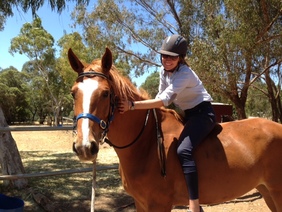
Foundation training (or "breaking-in" as it used to be known) is one of the most important parts of a horse's early training. During this phase the horse is trained to stop, go forwards and turn from light signals and habituated to the saddle, the weight of the rider and the different environments that he might have to work in as a riding horse. Along the way he'll also learn to park in cross ties, stand quietly at the mounting block and habituate to running water. It's an awful lot to learn in just four to six weeks, especially for a young horse that might still be finding his own balance and is probably coping with being away from home for the first time.
The training method that we use was first demonstrated by Kel Jeffries (in his book The Jeffries Method) and later refined by Andrew McLean. Sophie and I have adapted it a bit because we always work together. It's not a set formula, it's more like a series of guidelines and objectives that we work through. We use this method for both training and retraining and believe that it minimises the stress that can sometimes accompany times of rapid learning.
I really believe in this way of training because it's based on touch. I love watching horses running together in a paddock. I love how they rub and bump up against each other. Whether they are playing, fighting, grazing or resting – they do it together. The horse has 55 million years of evolution and in every part of that evolution he lived as part of a herd. So it's little wonder that we've found that when our horses become part of a herd they seem more content and more resilient to other stress. Horses form very strong bonds with each other and they mostly do it through physical contact. If we can't supply a herd of other horses then I think it's really important that we supplement that contact with our training.
The training method that we use was first demonstrated by Kel Jeffries (in his book The Jeffries Method) and later refined by Andrew McLean. Sophie and I have adapted it a bit because we always work together. It's not a set formula, it's more like a series of guidelines and objectives that we work through. We use this method for both training and retraining and believe that it minimises the stress that can sometimes accompany times of rapid learning.
I really believe in this way of training because it's based on touch. I love watching horses running together in a paddock. I love how they rub and bump up against each other. Whether they are playing, fighting, grazing or resting – they do it together. The horse has 55 million years of evolution and in every part of that evolution he lived as part of a herd. So it's little wonder that we've found that when our horses become part of a herd they seem more content and more resilient to other stress. Horses form very strong bonds with each other and they mostly do it through physical contact. If we can't supply a herd of other horses then I think it's really important that we supplement that contact with our training.
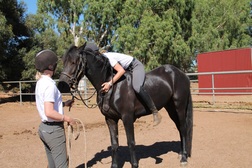
I think that modern horse keeping practices are very much at odds with our horse's evolution. Horses are often confined, isolated from each other and denied physical contact with other horses. Many modern training practices also fail to factor in the horse's need for touch because they're done at a distance. Lungeing and long reining, which usually form part of a traditional breaking-in, don't involve much, or any, physical contact between the horse and the handler. We can't run the young horses that are sent to us for training in a herd because it's not practical but we can make sure that their need for physical touch is in some part satisfied.
We do the first part of our foundation training bareback. It's a very good way to get the young horse used to the weight of a human without any stress. It also involves almost constant touch and the horses seem to really enjoy it. All the babies will finish their bareback session with lowered heads and slow blinking eyes. We've never had a horse that didn't become easier to catch after a few days of bareback training.
When the young horse has clear operantly conditioned responses in the halter – go, stop, back and park we introduce the bridle. Just a plain D sided snaffle with no noseband, nothing too fancy or heavy. We quietly and gently start to train the responses to the rein, using classical conditioning to get started. That is, we apply the new pressure just before applying the already conditioned response. So, light pressure on the reins starts just before light pressure on the noseband (the cue for back during ground work) and as soon as the horse takes a step back both pressures go away. Within about 5 repetitions most horses are stepping back from light pressure on the reins alone. Every single time the horse gives the right response the pressure goes sway – as it should throughout his entire ridden career. We also use lots of wither scratching as a reward and the whole process is really calm and quiet.
When the handler has good control over the horse's legs (this, and calmness are our two most important objectives in the first few days of training) we start habituating him to a rider. The rider pats him all over, leans over him, (from both sides) and when he's calmly accepting that, lies over him. I think it's really important to rub your legs and hands all over the horse's body, particularly over his rump and down his sides and make sure he sees you all over his body and out of both eyes. If he shows any fear the handler will just quietly step him back one step and we'll continue. We've had very few horses show any fear at all at this stage, they're usually so busy enjoying the scratching and the touch that they habituate really quickly.
Once the horse is happy to park with the rider's weight draped over them the rider can quietly (ensuring that the horse has seen the rider on both the left and right side of the neck) sit up. If you've done the early stages of the training well this step rarely causes any fear or concern. Once the horse is content to park with the rider astride the handler can ask him to step back quietly. It's always best for the horse to feel the moving weight of the rider first during a backwards step as it limits any expressions of the flight response.
We call the next phase "pony rides" because that's what it's like. The handler leads the horse around and the rider just sits there quietly, giving lots of wither scratches. Over the next few sessions the rider will gradually take over the control of the horse but the handler stays next to the horse on the ground to offer assistance if needed. In this way the young horse is habituated to the weight and the sight of the rider without any stress. He also learns to offer stop, go and turn from light signals without the need for any long reining or lungeing. It's a really enjoyable process for the rider and the handler and very rewarding. The horse gets lots of scratching and touch while gradually being habituated to something that might otherwise have been pretty scary.
We do the first part of our foundation training bareback. It's a very good way to get the young horse used to the weight of a human without any stress. It also involves almost constant touch and the horses seem to really enjoy it. All the babies will finish their bareback session with lowered heads and slow blinking eyes. We've never had a horse that didn't become easier to catch after a few days of bareback training.
When the young horse has clear operantly conditioned responses in the halter – go, stop, back and park we introduce the bridle. Just a plain D sided snaffle with no noseband, nothing too fancy or heavy. We quietly and gently start to train the responses to the rein, using classical conditioning to get started. That is, we apply the new pressure just before applying the already conditioned response. So, light pressure on the reins starts just before light pressure on the noseband (the cue for back during ground work) and as soon as the horse takes a step back both pressures go away. Within about 5 repetitions most horses are stepping back from light pressure on the reins alone. Every single time the horse gives the right response the pressure goes sway – as it should throughout his entire ridden career. We also use lots of wither scratching as a reward and the whole process is really calm and quiet.
When the handler has good control over the horse's legs (this, and calmness are our two most important objectives in the first few days of training) we start habituating him to a rider. The rider pats him all over, leans over him, (from both sides) and when he's calmly accepting that, lies over him. I think it's really important to rub your legs and hands all over the horse's body, particularly over his rump and down his sides and make sure he sees you all over his body and out of both eyes. If he shows any fear the handler will just quietly step him back one step and we'll continue. We've had very few horses show any fear at all at this stage, they're usually so busy enjoying the scratching and the touch that they habituate really quickly.
Once the horse is happy to park with the rider's weight draped over them the rider can quietly (ensuring that the horse has seen the rider on both the left and right side of the neck) sit up. If you've done the early stages of the training well this step rarely causes any fear or concern. Once the horse is content to park with the rider astride the handler can ask him to step back quietly. It's always best for the horse to feel the moving weight of the rider first during a backwards step as it limits any expressions of the flight response.
We call the next phase "pony rides" because that's what it's like. The handler leads the horse around and the rider just sits there quietly, giving lots of wither scratches. Over the next few sessions the rider will gradually take over the control of the horse but the handler stays next to the horse on the ground to offer assistance if needed. In this way the young horse is habituated to the weight and the sight of the rider without any stress. He also learns to offer stop, go and turn from light signals without the need for any long reining or lungeing. It's a really enjoyable process for the rider and the handler and very rewarding. The horse gets lots of scratching and touch while gradually being habituated to something that might otherwise have been pretty scary.
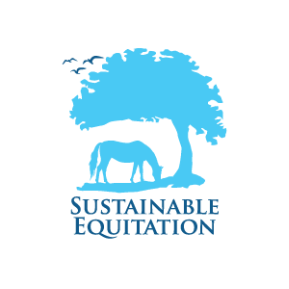
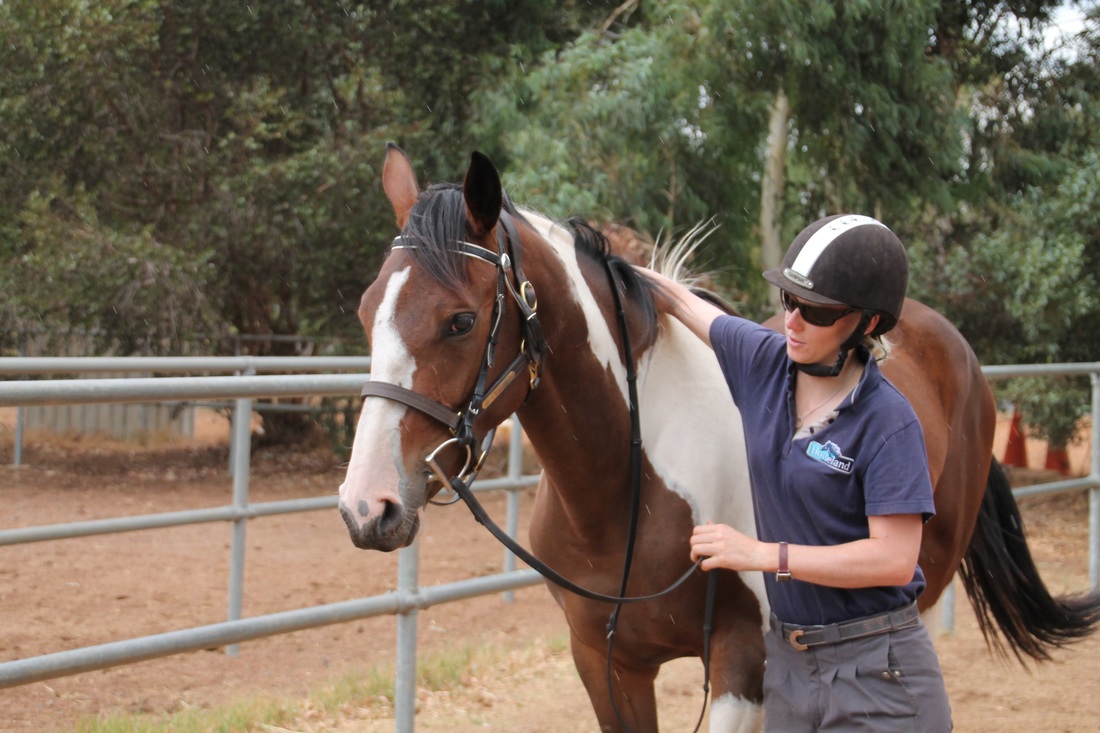
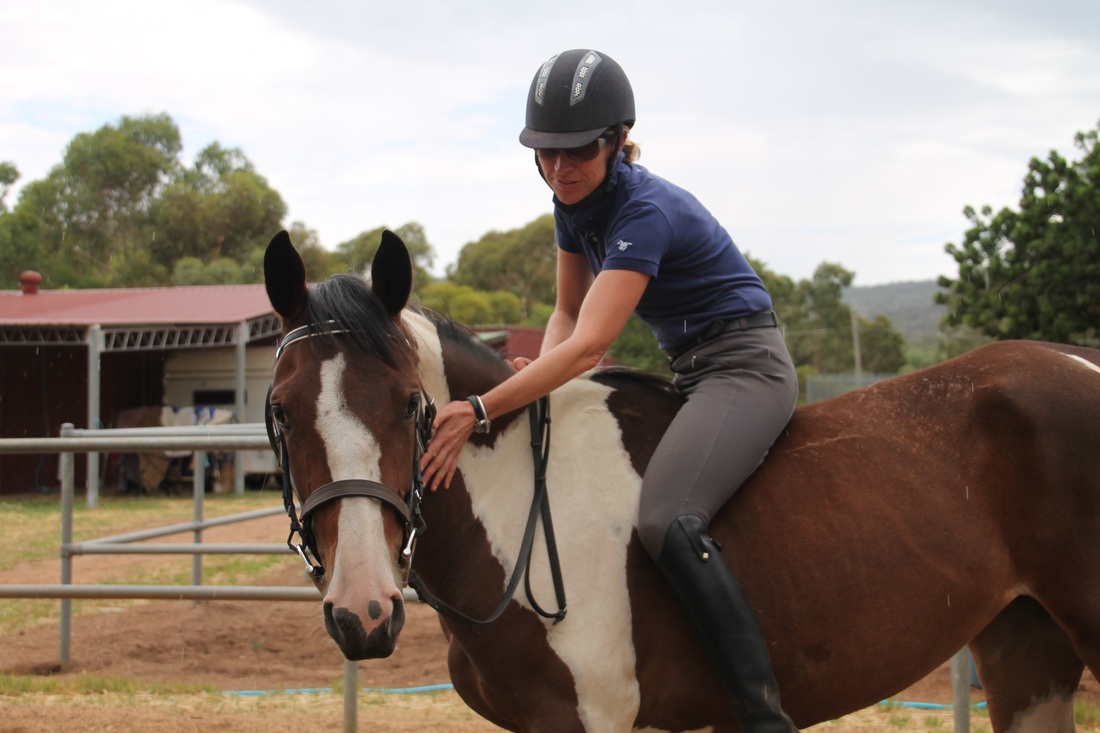
 RSS Feed
RSS Feed
